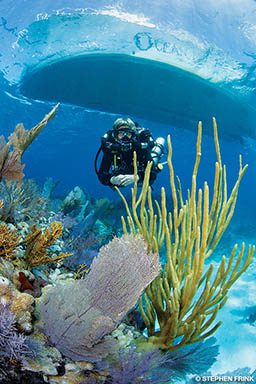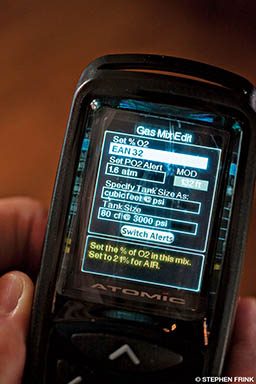On a recent dive charter to a popular wreck lying at 130 feet, cylinders filled with various gases belonging to an assortment of technical and recreational divers were stacked near the dive platform. An instructor teaching an advanced open-water course mistook my bailout cylinder filled with 50 percent oxygen for his pony bottle, which contained 32 percent oxygen. Fortunately, I was able to quickly find him underwater and trade bottles. No harm, no foul, but if he had breathed from my bottle deeper than about 70 feet he would have put himself at risk of convulsions and drowning.
The line between technical diving and recreational diving is becoming ever narrower. Divers use gases other than air for many reasons, but diving with the wrong gas mix can have serious consequences. To better understand these issues, let’s start by reviewing some concepts from our open-water and nitrox courses.

Dive Physics Review
Air has weight and exerts pressure on us. Pressure can be expressed in many ways — pounds per square inch (psi), inches of mercury (inHg), atmospheres (atm), bar, etc. At sea level the pressure of the air pushing down on us is 14.7 psi, 29.92 inHg, 1 atm or 1013.25 millibar. Water weighs much more than air, so it takes only 33 feet of seawater (or 34 feet of freshwater) to exert the same pressure as the entire column of air above us. When we dive, we are under the cumulative pressure of the air and water, so at 33 feet of seawater (fsw) we are under twice as much pressure as we are at the surface. Every 33 fsw increases the total surrounding pressure by 1 atm. Dive computers (and analog gauges) ignore the pressure of the air above the surface to display the depth; this reading is referred to as gauge pressure. These devices generally express depth in fsw.
The total pressure exerted by a gas mix is equal to the sum of the partial pressures of its component gases (Dalton’s law). The partial pressure of a component gas is determined by multiplying its percentage within a mixture by the absolute ambient pressure. (Absolute pressure, unlike gauge pressure, includes the pressure exerted by the air above the surface.) The two main gases in the air we breathe are oxygen and nitrogen. In round numbers, we breathe 21 percent oxygen and 79 percent nitrogen (the 1 percent of other gases present in air can be ignored for this discussion). So at surface pressure — 1 atmosphere absolute (ata) — the approximate partial pressure of oxygen (PO2) is 0.21, and the approximate partial pressure of nitrogen (PN2) is 0.79. It’s important to remember that the physiological effects of breathing gases are based on the partial pressure of the gas, not the percentage of the gas in the mixture.
Oxygen
Now we can begin to consider the ramifications of the various gases used in diving. Oxygen, of course, is the most important gas in our cylinders because we can’t survive without it. The oxygen content along with the inert gas content of our breathing mixes determine either how long we can remain within our no-decompression limit (NDL) or the depth and duration of required decompression stops.
Oxygen at high partial pressures can affect the central nervous system (CNS), potentially causing seizures that can lead to drowning. Oxygen can be toxic even at recreational depths. The amount of time spent breathing oxygen, previous exposure and exertion are all factors in the onset of oxygen toxicity, which can occur without warning. Taking certain medications before diving may also predispose individuals to CNS oxygen toxicity. The widely accepted safe partial pressure limit for oxygen during the working or bottom phase of a dive is 1.4, and most training organizations consider 1.6 to be acceptable at rest during decompression.
Inert Gases
The two inert gases most commonly used in sport diving today are nitrogen and helium. As we learned in our open-water diver course, nitrogen at higher partial pressures has a narcotic effect. The onset of nitrogen narcosis when diving with air or nitrox is generally felt at around 80-100 feet. Every individual is affected differently, and the effects can vary from dive to dive. Some people claim to be able to handle the narcosis on dives as deep as 200 feet but probably wouldn’t remember much if asked to describe the dive afterward. Several people have died attempting to set deep-diving records using air because they fell unconscious from the anesthetic effects of nitrogen under pressure.

Because helium is nonnarcotic, it has become standard practice to use it in mixes when diving to depths greater than about 150-165 feet, with some divers preferring to use helium on dives as shallow as 80 feet. A gas mixture comprising oxygen, nitrogen and helium is referred to as trimix, while a mix of just oxygen and helium is called heliox. The density of a gas increases with depth, so helium, a light gas, makes for easier work of breathing at depth. Work of breathing is a serious consideration for rebreather divers, because unlike in open-circuit scuba, breathing effort is required to move gas around the loop. An increase in breathing resistance results in the body producing more carbon dioxide (CO2). Many rebreather divers trained to use trimix commonly use some helium in their breathing gas to prevent an increase in CO2, particularly when diving deeper than 100 feet or in strenuous conditions.
Some drawbacks of using helium include the cost and difficulty of getting fills and an increase in heat loss. The duration of decompression and the effects of decompression sickness (DCS) associated with breathing helium must be considered when choosing a gas mix. When changing breathing gases during a dive, particularly from a nitrox mix to one with helium, divers must also consider isobaric counterdiffusion (ICD). In very simple terms, ICD is caused by one inert gas entering tissues while another inert gas is leaving; it can cause bubbles to form or grow, even without a change in depth. Additionally, during very deep dives, breathing helium can lead to a condition known as high-pressure nervous syndrome (HPNS), which can cause debilitating tremors and decreased mental performance.
Maximum Operating Depth
The maximum operating depth (MOD) of a gas mix is determined by calculating the depth at which the partial pressure of oxygen is 1.4 (or 1.6 for a decompression gas). The 1.4 PO2 limit for a gas with 21 percent oxygen (such as air) is 187 feet. To dive deeper, divers need to use a mix with a lower percentage of oxygen. A gas mix with less than 16 percent oxygen is considered hypoxic and if breathed at the surface or at shallow depths can cause immediate unconsciousness without warning. When using a hypoxic gas at depth, divers need to use another gas with a higher oxygen content, called a travel gas, to get them to a safe depth where they can switch to their hypoxic mix. On ascent, divers change to gases that contain increasing amounts of oxygen, with 100 percent oxygen commonly used at 20 feet and shallower.
Safety Precautions
The primary danger for nitrox divers and divers using multiple gases or cylinders is breathing a gas at an inappropriate depth. There are several important steps that divers should take to help prevent this potentially lethal error. Analyzing and marking cylinders is the first step in avoiding problems associated with breathing the wrong gas. In addition to having a sticker at the neck of the tank showing the diver’s name, the cylinder contents and the MOD of the gas, divers often tape the MOD in large numbers on the side of the cylinder so their teammates can see it during the dive.
To further help identify gases during the dive, many divers use different colored cylinders and/or regulators for each of their gases, with a green regulator cover used for cylinders containing 100 percent oxygen. Other methods used to ensure divers breathe from only the proper tank at the proper depth include putting tape labeled with the MOD on or near the regulator and putting a cover over the mouthpiece that must be removed before the diver can breathe from it. Just prior to diving, each cylinder should be analyzed, marked and attached to its regulator, one after another.
The general procedure for switching gases at depth is to verify that the MOD on the cylinder is equal to or deeper than the actual depth, trace the regulator back to the cylinder to ensure it’s connected properly, turn on the tank valve and then verify all teammates have switched to the correct gas. This procedure works well as long as the cylinders were properly analyzed and marked.
A dive fatality occurred a few years ago when a diver used a cylinder marked as having 100 percent oxygen at 95 feet. His teammates saw the marking and asked if he had analyzed the gas before the dive. He assured them that he had filled it with air himself. The accident analysis determined that the tank did contain 100 percent oxygen and that he had died as a result of CNS oxygen toxicity.
One of the reasons we dive with buddies is to have redundant brains, but these are valuable only when they’re actually used. When someone has more experience than we do, is an instructor or is known as an expert in the industry, we might be reluctant to question his or her procedures or lack thereof. The same phenomenon was present in aviation many years ago: Flight crew members were reluctant to question the authority of the captain. Crew resource management (CRM) was developed after several accident investigations revealed that crew members were ineffective at pointing out errors that eventually led to accidents. CRM training is now mandated by the U.S. Federal Aviation Administration (FAA) and involves both ground and cabin crews. It is also used in the U.S. military and for firefighting and health-care personnel. Using CRM in diving means every member of a dive team not only is responsible for his or her own safety but also is committed to ensuring that everyone returns safely from the dive. Everyone in the team must be comfortable with questioning all other team members, including the leader or instructor, when something doesn’t seem right, and no one should feel above being questioned.
With increased availability of instruction, equipment and opportunities, the number of divers participating in what has traditionally been considered technical diving is growing. With an eagerness to go to greater lengths and depths for exploration, many divers are progressing through courses such as sidemount, rebreather, trimix, cavern and cave diving. It’s up to all of us to help ensure simple mistakes don’t have tragic consequences.
| © Alert Diver — Q2 2017 |